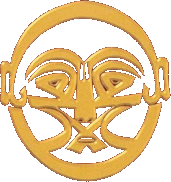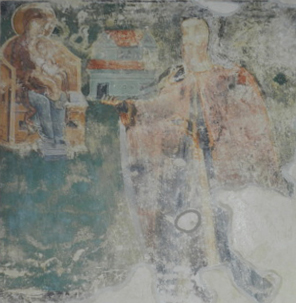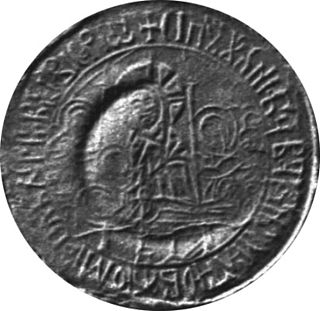 W
WMoshe Alshich Hebrew: משה אלשיך, also spelled Alshech, (1508–1593), known as the Alshich Hakadosh , was a prominent rabbi, preacher, and biblical commentator in the latter part of the sixteenth century.
 W
WAntonije I Sokolović was the Archbishop of Peć and Serbian Patriarch from 1571 to 1574. He was the second primate of the restored Serbian Patriarchate of Peć, and nephew of previous Serbian Patriarch Makarije I.
 W
WAyşe Hümaşah Sultan was an Ottoman princess, the only daughter of Mihrimah Sultan of the Ottoman Empire and Rüstem Pasha. She was granddaughter of Suleiman the Magnificent (1520–1566) and his favorite consort and legal wife, Hurrem Sultan.
 W
WBanul Mărăcine or Mărăcină, common rendition of Barbu III Craiovescu, Barbu Mărăcine or Barbu Basarab, was a historical figure in Wallachia, who claimed the title of Prince. He was one of several Craiovești pretenders to the throne, a category which also included his father, Preda Craiovescu. Mărăcine himself entered historical record in 1532, when, as an opponent of Prince Vlad VI, he had his estate confiscated. He returned to favor later that year, with the crowning of Vlad Vintilă de la Slatina. Like Preda before him, Mărăcine served as Ban of Oltenia, becoming the last of his family to hold that title. According to various accounts, he turned against his new lord, from organizing armed resistance in Oltenia to involving himself in Vlad Vintilă's assassination. He was able to maintain his position following the crowning of Radu Paisie, but was eventually toppled by the latter in mid 1535.
 W
WHayreddin Barbarossa, also known as Hızır Hayrettin Pasha, and simply Hızır Reis , was an Ottoman corsair and later admiral of the Ottoman Navy. Barbarossa's naval victories secured Ottoman dominance over the Mediterranean during the mid 16th century.
 W
WŞehzade Cihangir was an Ottoman prince. He was the sixth and youngest child of Sultan Suleiman the Magnificent and his wife Hurrem Sultan.
 W
WSünbül Efendi was the founder of the Sunbuliyye Sufi order. The Sunbuliyye were a derivative of the Khalwati order. Sünbül Efendi's successors, the next generations were settled in Nurullah town by Konur, Icel Province around 1550.
 W
WFakhr-al-Din ibn Maan, also known as Fakhreddine and Fakhr-ad-Din II, was a Druze Ma'an Emir and an early leader of the Mount Lebanon Emirate, a self-governed area subject to the Ottoman Empire.
 W
WAlvise Gritti, whose first name may also be spelled Aloisio, Lodovico, Ludovico, Luigi or Louis, was a Venetian politician. He was influential in the Hungarian Kingdom under the reign of King John I of Hungary. He was also a minister of the Ottoman sultan, and regent of Hungary from 1530 to 1534. He was the natural son of Andrea Gritti, the Venetian Bailo of Constantinople during the reign of Sultan Bayezid II and who later became the Doge of Venice in 1523.
 W
WHasan Agha or Hadım Hassan Ağa, also Hassan the eunuch, was a Sardinian renegade and effective ruler of the Regency of Algiers from 1533 to 1545. He was the deputy of Hayreddin Barbarossa, who left him in command when he had to leave for Constantinople in 1533.
 W
WGazi Husrev-beg was an Ottoman Bosnian sanjak-bey (governor) of the Sanjak of Bosnia in 1521–1525, 1526–1534, and 1536–1541. He was known for his major contribution to the improvement of the structural development of Sarajevo urban area and his construction of many important buildings there, such as the Gazi Husrev-beg Mosque or the medresa Kuršumlija, as well as for his successful conquests and for the launching of further Ottoman expansion into Croatia.
 W
WJanus Bey, in Turkish Yunus Bey was a Greek who became an interpreter (dragoman) and ambassador for the Ottoman Empire.
 W
WJovan Kantul, sometimes numbered Jovan II was the Archbishop of Peć and Serbian Patriarch, the spiritual leader of the Serbian Orthodox Church, from 1592 until his death in 1614. He planned a major revolt in the Ottoman Balkans, with Grdan, the vojvoda of Nikšić, asking the pope for aid. Owing to his activities for planning a Serbian revolt, he was arrested and put on trial in Istanbul in 1612. He was found guilty of treason and was executed two years later (1614).
 W
WMahidevran was the consort of Suleiman the Magnificent of the Ottoman Empire and the mother of Şehzade Mustafa.
 W
WMimar Hayruddin was an Ottoman chief architect and civil engineer under the rule of Sultan Bayezid II from and Sultan Suleiman the Magnificent.
 W
WMustafa ibn Ali al-Muwaqqit, also known as Müneccimbaşı Mustafa Çelebi and Koca Saatçi, was an Ottoman astronomer and author of geography from the sixteenth century. Because of his works on the science of timekeeping and practical astronomy, he is considered "the founder of the Ottoman tradition" of those fields. He was one of the pioneers of astronomy literature in Ottoman Turkish—instead of Arabic which was more common in the Islamic world—following Muhammad al-Qunawi. Since his youth he served as the muwaqqit attached to the Mosque of Selim I in Istanbul, in which capacity he produced most of his writing. In 1560 or later he was appointed to the office of müneccimbaşı, the highest post for astronomers of the Empire.
 W
WŞehzade Mustafa was an Ottoman prince as the eldest son of Sultan Suleiman the Magnificent and his consort Mahidevran Sultan. He was the prince-governor of Manisa from 1533 to 1541, of Amasya from 1541 to 1549, and of Konya from 1549 to 1553. Şehzade Mustafa was the heir apparent to the Ottoman throne and an immensely popular prince among the army and the populace prior to his execution, by the order of his father Suleiman.
 W
WNakkaş Osman was the chief miniaturist for the Ottoman Empire during the later half of the sixteenth century. The dates of his birth and death are poorly known, but most of his works are dated to the last quarter of the sixteenth century.
 W
WStarina Novak was a Serb hajduk who distinguished himself in many battles against the Ottoman Empire. He is considered a national hero by both the Serbs and the Romanians.
 W
WPetar Ovčarević was an Ottoman and then Hungarian river flotilla commander, who during his Ottoman service spied and informed the Christian army on the intentions and movements of the Ottoman army. His last years were spent in the Eastern Hungarian Kingdom, as one of the most notable magnates.
 W
WAhmed Muhiddin Piri, better known as Piri Reis, was an Ottoman admiral, navigator, geographer and cartographer.
 W
WŞahkulu also known as Shah-Qoli Baba, Shahqoli Baba, or Karabıyıkoğlu, was the leader of the pro-Shia and pro-Safavid uprising in Anatolia – the Şahkulu Rebellion – directed against the Ottoman Empire in 1511. He was viewed as a Messiah and Prophet by his followers. His death in battle signified the end of the uprising. He is buried in Amasya.
 W
WŞehzade Bayezid was an Ottoman prince as the son of Sultan Suleiman the Magnificent and Hurrem Sultan. After the execution of Şehzade Mustafa in 1553, Bayezid became the popular heir among the army. Throughout the 1550s, when Suleiman was already in his 60s, a protracted competition for the throne between Bayezid and his brother Selim became evident. Bayezid had fallen into disfavor with his father – who was angered by Bayezid's disobedience stemming from around the same years – as opposed to Selim. After being defeated in a battle near Konya in 1559 by Selim and Sokullu Mehmet Pasha, he fled to the neighbouring Safavid Empire, where he was lavishly received by Tahmasp I. However, in 1561, on the continuous insistence of the Sultan throughout his son's exile, and after several large payments, Tahmasp allowed Bayezid to be executed by agents of his own father.
 W
WSinan Reis, also Ciphut Sinan, "Sinan the Chief", and Portuguese: Sinao o Judeo, "Sinan the Jew", was a Barbary corsair and Jewish pirate who sailed under the famed Ottoman admiral Hayreddin Barbarossa.
 W
WMimar Sinan c. 1488/1490 – July 17, 1588) was the chief Ottoman architect and civil engineer for sultans Suleiman the Magnificent, Selim II, and Murad III. Known as Koca Mi'mâr Sinân Âğâ, "Sinan Agha the Grand Architect", he was responsible for the construction of more than 300 major structures and other more modest projects, such as schools. His apprentices would later design the Sultan Ahmed Mosque in Istanbul and Stari Most in Mostar.
 W
WMakarije Sokolović was the Archbishop of Peć and Serbian Patriarch from 1557 to 1571. He was the first head of the restored Serbian Patriarchate of Peć, after its lapse in 1463 that resulted from the Ottoman conquest of Serbia. He is variously reported to have been the brother, nephew, or first cousin of the Ottoman Grand Vizier Mehmed-paša Sokolović, who used his influence in the Ottoman Empire to reestablish the Serbian Patriarchate with its seat in Monastery of Peć. Patriarch Makarije is celebrated as a saint in the Serbian Orthodox Church.
 W
WSavatije Sokolović, was Archbishop of Peć and Serbian Patriarch from 1585 to 1586. Before that, he served as Metropolitan of Herzegovina from 1573 to 1585. He was a member of the notable Sokolović family, being a nephew of Serbian Patriarch Makarije Sokolović (1557–71). Savatije founded the Piva Monastery in 1573.
 W
WVisarion was the Metropolitan of Herzegovina between 1590 and 1602.
 W
WHayyim ben Joseph Vital was a rabbi in Safed and the foremost disciple of Isaac Luria. He recorded much of his master's teachings. After Vital's death, his writings began to spread and led to a "powerful impact on various circles throughout the Jewish world."